Scaffolding planks, one of the most important components of a scaffolding system, provide a surface on which construction workers and equipment can stand or be supported. Below we will give you an overview of several common types of scaffold planks:
Wooden plank:
There are two types of planks commonly used in construction, solid-sawn planks and laminated single planks. Solid boards are usually made from pine or fir. The advantages of wooden scaffold boards are that they are light and provide good traction for workers and a sturdy working surface.
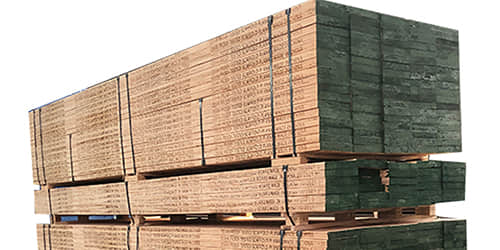
Scaffold Steel plank:
Scaffolding steel planks have gradually replaced wooden boards in engineering buildings. They have good strength, durability, and great load-bearing capacity. They are usually galvanized, powder-coated, or painted and are suitable for all weather conditions.
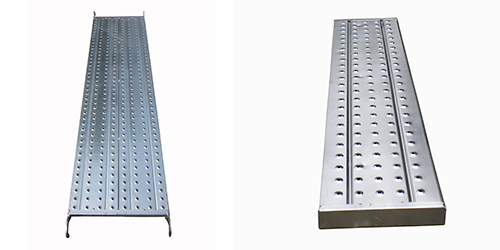
Aluminum plank:
Aluminum walking planks are lighter in weight than steel scaffold planks, more durable than wooden boards, and have the advantage of corrosion resistance. The price of aluminum planks is also relatively expensive.
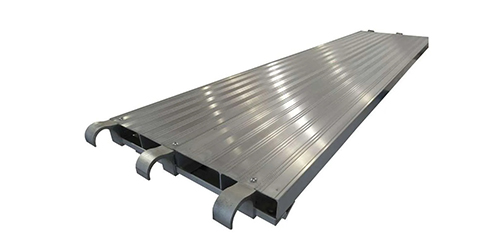
Main features of scaffolding steel plank:
Design:
- The surface of the steel plank is usually designed with a series of perforations or raised ribs to enhance traction and reduce the risk of workers slipping.
Length and width:
- They are available in a variety of lengths and widths to accommodate different scaffolding configurations and project requirements. Includes 9-inch steel plank for one person and 18-inch for two people.
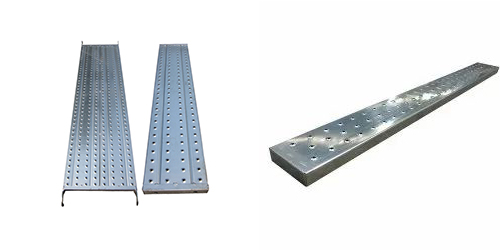
Carrying capacity:
- Steel board have specific load-carrying capabilities that ensure they can safely support the weight of workers, tools, and materials. However, for safety reasons, their load ratings must be observed when using them.
End hook or lug:
- Many steel planks have end hooks or lugs, both with and without hooks. The steel plank with hooks can be better fixed and not easy to move.
Metal Scaffold Boards Application:
Working platform:
- Steel planks are the primary working platform of scaffolding, providing a level and safe surface for construction workers to perform tasks such as painting, plastering, or bricklaying.
Material support:
- Steel planks are used to support construction materials, tools, and equipment, giving workers easy access to what they need when working at heights.
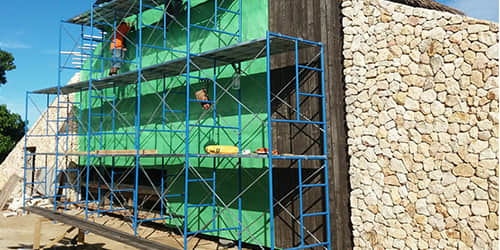
Entrance and exit:
- Steel planks are used to create pathways or ramps to allow workers to access different levels of scaffolding structures easily.
Security considerations:
Periodic inspection:
- Steel plank should be inspected regularly for signs of damage, including corrosion, bending, or structural defects.
Install correctly:
- Steel planks should be installed correctly and have safety end hooks or lugs to prevent accidental displacement.
Load limit:
- Adherence to load capacity limits is essential to prevent overloading and ensure worker safety and scaffold stability.
Investing in quality scaffolding boards is essential to ensure the safety of workers and equipment on the scaffolding structure. For scaffolding panels, you can trust for your most critical applications, talk to the experts at AJ Building.
We offer steel planks with superior strength, stability, durability, and reliability at competitive prices.
FAQ
What Is The Standard Scaffold Plank?
- The standard dimensions for a new scaffold board are a thickness of 38mm, a width of 225mm, and lengths up to 3.9 meters (13 feet).
What Is Two Plank Scaffold?
- A two plank scaffold is a type of scaffold that utilizes two planks side by side to create the working platform.
How Far Can A Scaffold Plank Extend?
- The maximum overhang for scaffold planks should not exceed 12 inches (30.5 cm) unless the plank is designed and secured to prevent movement.
Related Information
How to Build Wood Scaffolding Planks --- YOUTUBE
Are The Scaffold Boards You'Re Using In A Safe Condition? --- HSA
What Is A Scaffolding Plank? --- QUORA



